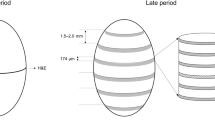Abstract
The aim of this study is to evaluate the outcome of occult breast cancer (OBC) in patients with axillary presentation overall and according to the immunohistochemically defined tumour subtypes. We reviewed information on 15,490 consecutive primary breast cancer patients, who underwent surgery at the European institute of oncology between September 1997 and December 2008. Patients with OBC were compared with an equal number of patients with small invasive breast carcinomas (pT1) observed at the same institution during the same period, matched for year of surgery, age, nodal status and biological features. Eighty patients with OBC (study group) and 80 patients with early breast cancer (control group) were identified. There was no significant difference in the disease-free survival (5 years DFS 66 vs. 68% P = 0.91) and the overall survival (5 years OS 80 and 86% P = 0.99) between the OBC and control groups. A statistically significant worse outcome was observed within the group of OBC for patients with more than four involved lymph nodes and with triple negative tumours. The outcome of OBC patients is comparable with that of matched patients with small sized breast cancer. High risk of relapse and death was observed in OBC patients with triple negative tumours and extensive nodal involvement.


Similar content being viewed by others
References
Vilcoq JR, Calle R, Ferme F et al (1982) Conservative treatment of axillary adenopathy due to a probable subclinical breast cancer. Arch Surg 117:1136–1138
Owen HW, Dockerty MB, Gray HK (1954) Occult carcinoma of the breast. Surg Gynecol Obstet 98:302–308
Galimberti V, Bassani G, Monti S et al (2004) Clinical experience with axillary presentation breast cancer. Br Can Res and Treat 88:43–47
Newman LA, Singletary SE (2007) Overview of adjuvant systemic therapy in early stage breast cancer. Surg Clin North Am 87:499–509
Vezzoni P, Balestrazzi A, Bignami P et al (1979) Axillary lymph node metastases from occult carcinoma of the breast. Tumori 65:87–91
Rosen PP, Kimmel M (1990) Occult breast carcinoma presenting with axillary lymph node metastases. A follow-up study of 48 patients. Hum Pathol 21:518–524
Merson M, Andreola S, Galimberi V et al (1992) Breast carcinoma presenting as axillary metastases without evidence of a primary tumour. Cancer 70:504–508
Kyokane T, Akashi-Tanaka S, Matsui T et al (1995) Clinicopathological characteristics of non-palpable breast cancer presenting as an axillary mass. Breast Cancer 2:105–112
Perou CM, Sorlie T, Eisen MB et al (2000) Molecular portraits of human breast tumours. Nature 406(6797):747–752
de Ronde JJ, Hannemann J, Halfwerk H et al (2010) Concordance of clinical and molecular breast cancer subtyping in the context of preoperative chemotherapy response. Breast Cancer Res Treat 119(1):119–126
Cheang MC, Chia SK, Voduc D et al (2009) Ki67 Index, HER2 status, and prognosis of patients with Luminal B breast cancer. J Natl Cancer Inst 101(10):736–750
Hugh J, Hanson J, Cheang MC et al (2009) Breast cancer subtypes and response to docetaxel in node-positive breast cancer: use of an immunohistochemical definition in the BCIRG 001 trial. J Clin Oncol 27:1168–1176
Cancello G, Maisonneuve P, Rotmensz N et al (2010) Prognosis and adjuvant treatment effects in selected breast cancer subtypes of very young women (<35 years) with operable breast cancer. Ann Oncol 21:1974–1981
Colleoni M, Cole BF, Viale G et al (2010) Classical cyclophosphamide, methotrexate, and fluorouracil chemotherapy is more effective in triple-negative, node-negative breast cancer: results from two randomized trials of adjuvant chemoendocrine therapy for node-negative breast cancer. J Clin Oncol 28(18):2966–2973
Colleoni M, Orvieto E, Nolè F et al (1999) Prediction of response to primary chemotherapy for operable breast cancer. Eur J Cancer 35:574–579
Kalbfleisch JD, Prentice RL (1980) The statistical analysis of failure time data. Wiley, San Francisco
Gray RJ (1988) A class of K-sample tests for comparing the cumulative incidence of a competing risk. Ann Statist 16:1141–1154
Svastics E, Ronay P, Bodo M (1993) Occult breast cancer presenting with axillary metastasis. Eur J Surg Oncol 19 (Suppl 1):575–580
Jackson B, Scot-Conner C, Moulder J (1995) Axillary metastasis from occult breast carcinoma: diagnosis and management. Am Surg 61:431–434
Pentheroudakis G, Lazaridis G, Pavlidis N (2010) Axillary nodal metastases from carcinoma of unknown primary (CUPAx): a systematic review of published evidence. Breast Cancer Res Treat 119:1–11
Panoff JE, Hurley J, Takita C et al (2011) Risk of locoregional recurrence by receptor status in breast cancer patients receiving modern systemic therapy and post-mastectomy radiation. Breast Cancer Res Treat 899–906
Dent R, Trudeau M, Pritchard KI et al (2007) Triple negative breast cancer: clinical features and patterns of recurrence. Clin Cancer Res 13(15 Pt 1):4429–4434
Bassarova AV, Nesland JM, Sedloev T et al (2005) Simultaneous bilateral breast carcinomas: a category with frequent coexpression of HER-2 and ER-alpha, high Ki-67 and bcl-2, and low p53. Int J Surg Pathol 13(3):239–240
Tanner M, Järvinen P, Isola J (2001) Amplification of HER-2/neu and topoisomerase IIalpha in primary and metastatic breast cancer. Cancer Res 15 61(14):5345–5348
Iguchi C, Nio Y, Itakura M et al (2003) Heterogenic expression of oestrogen receptor between the primary tumour and the corresponding involved lymph nodes in patients with node-positive breast cancer and its implications in patient outcome. J Surg Oncol 83:85–93
Kamby C, Rasmussen BB, Kristensen B et al (1989) Oestrogen receptor status of primary breast carcinomas and their metastases. Relation to pattern of spread and survival after recurrence. Br J Cancer 60:252–257
Goldhirsch A, Glick JH, Gelber RD et al (1998) Meeting highlights: International Consensus Panel on the Treatment of Primary Breast Cancer. J Natl Cancer Inst 90:1601–1608
Goldhirsch A, Ingle JN, Gleber RD et al (2009) Thresholds for therapies: highlights of the St Gallen International expert consensus on the primary therapy of early breast cancer. Ann Oncol 20(8):1319–1329
Author information
Authors and Affiliations
Corresponding author
Rights and permissions
About this article
Cite this article
Montagna, E., Bagnardi, V., Rotmensz, N. et al. Immunohistochemically defined subtypes and outcome in occult breast carcinoma with axillary presentation. Breast Cancer Res Treat 129, 867–875 (2011). https://doi.org/10.1007/s10549-011-1697-6
Received:
Accepted:
Published:
Issue Date:
DOI: https://doi.org/10.1007/s10549-011-1697-6




